Volvo TAD650VE, TAD660VE, TAD734GE, TAD750VE, TAD760VE Service Manual
Workshop Manual |
|
|
I |
||
Group 30 |
|
|
4(0) |
||
|
||
|
|
TAD650VE, TAD660VE, TAD734GE, TAD750VE, TAD760VE

7747632 English 03–2007
Group 30 Electrical system
Industrial Engines
TAD734GE, TAD650VE, TAD660VE, TAD750VE,
TAD760VE
Contents
Safety rules ............................................................ |
3 |
General information .............................................. |
4 |
About this Workshop Manual ............................... |
4 |
Spare parts .......................................................... |
4 |
Certified engines .................................................. |
4 |
Repair instructions ................................................ |
5 |
Our common responsibility ................................... |
6 |
Tightening torques ............................................... |
6 |
Special tools ......................................................... |
7 |
EMS 2 - “Engine Management System” .............. |
8 |
General information .............................................. |
8 |
CAN - Controller Area Network ............................. |
8 |
CIU - Control Interface Unit .................................. |
9 |
DCU - Display Control Unit ................................... |
9 |
Fuel control ........................................................ |
10 |
Calculation of fuel quantity ................................. |
10 |
Altitude correction .............................................. |
10 |
Diagnostic function ............................................ |
10 |
Component location ........................................... |
11 |
TAD 650, 660, 750, 760 VE ............................... |
11 |
TAD 734 GE ...................................................... |
12 |
Component description ...................................... |
13 |
Starter motor ...................................................... |
13 |
Alternator ........................................................... |
13 |
Injectors ............................................................. |
14 |
Speed sensor, crankshaft .................................. |
14 |
Speed sensor, camshaft .................................... |
14 |
Sensor, boost pressure/ |
|
boost temperature .............................................. |
15 |
Sensor, oil pressure, engine ............................... |
15 |
EGR ................................................................... |
15 |
Coolant temperature sensor ............................... |
16 |
Sensor, common rail pressure (fuel) ................... |
16 |
Sensor, fuel pressure ......................................... |
16 |
Magnetically controlled proportional valve |
|
(MPROP) ........................................................... |
17 |
Water in fuel switch, secondary fuel filter .......... |
17 |
Switch, coolant level .......................................... |
17 |
Preheater ........................................................... |
18 |
Engine control unit, EMS 2 ................................ |
18 |
Repair instructions .............................................. |
19 |
General advice on working with EMS engines .... |
19 |
Electric welding .................................................. |
20 |
Changing the engine control unit ........................ |
21 |
Reprogramming a control unit ............................. |
22 |
Programming an empty control unit .................... |
23 |
Fault tracing of cables and connectors ............... |
24 |
Checking the starter motor voltage ..................... |
26 |
Checking the charging system ........................... |
27 |
Rail pressure measurement ................................ |
28 |
Malfunctions ........................................................ |
29 |
Fault code information ........................................ |
29 |
FMI table / SAE standard .................................. |
30 |
Manual fault tracing in bus cables ...................... |
33 |
Diagnostic Trouble Codes .................................. |
34 |
MID 128, PID 45 |
|
Inlet air heater status ......................................... |
34 |
MID 128, PID 94 |
|
Fuel pressure ..................................................... |
37 |
MID 128, PID 97 |
|
Water in fuel ....................................................... |
43 |
MID 128, PID 100 |
|
Oil pressure ....................................................... |
46 |
MID 128, PID 105 |
|
Boost temperature ............................................. |
52 |
MID 128, PID 106 |
|
Boost pressure ................................................... |
58 |

MID 128, PID 108 |
|
Ambient air pressure .......................................... |
64 |
MID 128, PID 110 |
|
Coolant temperature ........................................... |
66 |
MID 128, PID 111 |
|
Coolant level ...................................................... |
72 |
MID 128, PID 158 |
|
Battery voltage ................................................... |
76 |
MID 128, PID 164 |
|
Rail pressure ...................................................... |
78 |
MID 128, PID 190 |
|
Engine speed ..................................................... |
84 |
MID 128 / MID 144, PPID 4 |
|
Start input CIU ................................................... |
85 |
MID 128 / MID 144, PPID 6 |
|
Engine stop switch ............................................. |
87 |
MID 128, PPID 19 |
|
Internal EGR status ........................................... |
89 |
MID 128, PPID 55 |
|
EMS temperature ............................................... |
93 |
MID 128, PPID 98 |
|
Engine sync acknowledge .................................. |
95 |
MID 128 / 144, PPID 132 |
|
Throttle input request failure, DCU/CIU .............. |
97 |
MID 128, SID 1-6 |
|
Injector common rail # 1-6 ................................. |
100 |
MID 128, SID 21 |
|
Speed sensor camshaft .................................... |
105 |
MID 128, SID 22 |
|
Speed sensor, crankshaft ................................. |
110 |
MID 128, SID 39 |
|
Engine starter relay ........................................... |
115 |
MID 128, SID 42 |
|
Injection control pressure regulator .................... |
118 |
MID 128, SID 70 |
|
Preheat sense ................................................... |
122 |
MID 128, SID 211 |
|
5V sensor supply 2 ........................................... |
124 |
MID 128, SID 231 |
|
Communication fault J 1939 .............................. |
126 |
MID 128, SID 232 |
|
5V sensor supply 1 ........................................... |
129 |
MID 128, SID 240 |
|
Program memory .............................................. |
131 |
MID 128, SID 254 |
|
Controller error .................................................. |
132 |
MID 128, PSID 96 |
|
Rail pressure system ........................................ |
133 |
MID 128, PSID 97 |
|
Rail pressure release valve ............................... |
137 |
MID 128 / MID 144, PSID 201 |
|
J1939 communication bus ................................ |
141 |
Engine protection .............................................. |
144 |
TAD 650, 660, 750, 760 VE .............................. |
144 |
TAD 734 GE ..................................................... |
145 |
Wiring diagrams ................................................. |
146 |
Wiring diagram EMS 2: |
|
Vechicle harness TAD 650-760VE ................... |
146 |
Engine harness TAD 650-760VE ...................... |
147 |
Engine harness TAD 734GE ............................ |
148 |
Wiring diagram DCU .......................................... |
149 |
Wiring diagram CIU ........................................... |
150 |
Technical data .................................................... |
151 |
Switch, water in fuel .......................................... |
151 |
Sensor, fuel pressure ........................................ |
151 |
Speed sensor, camshaft / |
|
Speed sensor, crankshaft ................................. |
151 |
Sensor, oil pressure .......................................... |
151 |
Sensor, rail pressure ......................................... |
151 |
Combination sensor, |
|
boost pressure/boost temperature ..................... |
152 |
Sensor, coolant temperature ............................. |
152 |
Switch, coolant level ......................................... |
152 |
Alternator .......................................................... |
152 |
Starter motor ..................................................... |
152 |
Index ................................................................... |
153 |
References to Service Bulletins ........................ |
153 |
© 2007 AB VOLVO PENTA
We reserve the right to make modifications without prior notice.
Printed on environmentally compatible paper.
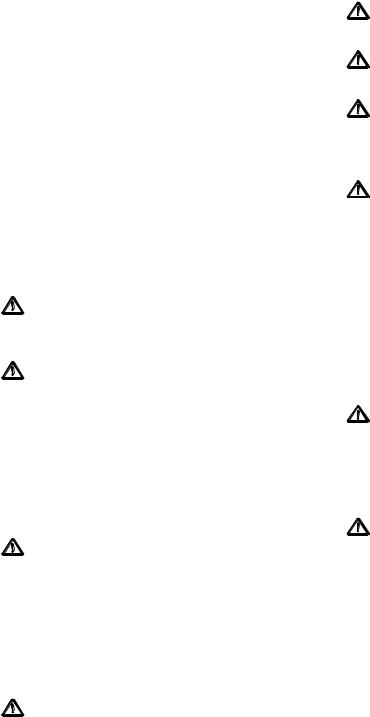
Group 30: Electrical system |
Safety information |
|
|
Safety rules
Introduction
This workshop manual contains technical data, descriptions and repair instructions for the Volvo Penta products or product versions noted in the table of contents. Check that you have the correct Workshop Manual for your engine.
Read the available safety information, ”General information” and ”Repair instructions” in this workshop manual before you start to do any service work.
Important!
The following special warning symbols occur in this book and on the engine.
WARNING! Warns for the risk of personal injury, property damage or that a mechanical fault can occur if the instructions are not followed.
IMPORTANT! Is used to call attention to things which could cause damage or malfunctions to product or property.
NOTE! Is used to call attention to important information, to facilitate work processes or operation.
Below is a summary of the risks involved and safety precautions you should always observe or carry out when performing work on the EMS 2 system.
Before electric welding is done, the connector on the EMS system must be disconnected. Disconnect the engine from system voltage by turning off the main switch.
Disconnect the cable connectors from the control unit.
Reconnect the EMS 2 control module terminal when the electric welding is finished and the electric welding equipment has been disconnected.
Be careful, watch out for the moving components of the engine during function testing and in operation. Approaching the engine during operation entails a risk of personal injury. Remember that loose clothes or long hair can catch on rotating components and cause severe injury.
Never do any work on an engine which just hangs from a lifting device (crane etc.).
The engine must not be run in areas where explosive material or any gases are stored.
Only start the engine in a well-ventilated area. If the engine is run in a confined space, make sure that the crankcase ventilation and exhaust gases can be led away from the workplace.
The battery lockers must never be exposed to open flames or sparks. Never smoke close to the batteries. The batteries generate hydrogen gas when charged, which can form an explosive gas when mixed with air. This gas mixture is very flammable and highly explosive. A spark, which can be caused by incorrect battery connection, can cause a single spark which is sufficient to cause an explosion with resulting damage. Do not shift the connections when attempting to start the engine (spark risk) and do not lean over any of the batteries. Please refer to the advice in the instruction book.
Always ensure that the + (positive pole) and – (negative pole) are securely connected to their appropriate terminals on the battery. If the batteries are wrongly connected, this can cause severe damage to the electrical equipment. Please refer to the wiring diagram.
Always use goggles when charging and handling batteries. Battery electrolyte contains sulfuric acid, which is highly corrosive. If battery acid comes into contact with your skin, wash it off at once with a lot of soap and water, and then get medical help. If battery acid comes into contact with your eyes, flush your eyes at once (preferably with an eye shower) with a lot of clean water, and then get medical help at once.
3

Group 30: Electrical system |
General information |
|
|
General information
About this Workshop Manual
This workshop manual contains descriptions and repair instructions for the standard versions of the TAD734GE, TAD650VE, TAD660VE, TAD750 and TAD760VE engines.
The workshop manual can illustrate tasks done on any of the engines noted above. This means that the illustrations and photographs which clarify certain details might not correspond with other engines in some cases. Repair methods are similar in all important respects, however. If this is not the case, this is noted. Important differences are noted separately.
The engine designation and number are noted on the number plate and engine decal. The engine designation and number must always be given in all correspondence about any product.
The workshop manual is produced primarily for the use of Volvo Penta workshops and service technicians. For this reason the manual presupposes a certain basic knowledge and that the user can carry out the mechanical/electrical work described to a general standard of engineering competence.
Volvo Penta constantly improves its products, so we reserve the right to make modifications without prior notification. All information in this manual is based on product data which was available up to the date on which the manual was printed. Any material changes introduced into the product or service methods after this date are notified by means of Service Bulletins.
Spare parts
Spare parts for electrical and fuel systems are subject to various national safety requirements. Volvo Penta Original Spare Parts meet these specifications. Any kind of damage whatsoever, occasioned by use of non-original Volvo Penta spares for the product in question, will not be compensated by the warranty offered by Volvo Penta.
Certified engines
When doing service and repair on emission certified engines, it is important to be aware of the following:
Certification means that an engine type has been checked and approved by the relevant authority. The engine manufacturer guarantees that all engines made of the same type are equivalent to the certified engine.
This makes special demands on service and repair work, as follows:
●Maintenance and service intervals recommended by Volvo Penta must be complied with.
●Only Volvo Penta original spares may be used.
●Service to injection pumps, pump settings and injectors must always be done by an authorized Volvo Penta workshop.
●The engine must not be converted or modified, except for the accessories and service kits which Volvo Penta has approved for the engine.
●No installation changes to the exhaust pipe and engine air inlet ducts may be done.
●No seals may be broken by unauthorized personnel.
The general advice in the instruction book about operation, care and maintenance applies.
IMPORTANT! Delayed or inferior care/maintenance, and the use of non-original spares parts means that Volvo Penta can no longer be responsible for guaranteeing that the engine complies with the certified version.
Damage and/or costs which arise from this will not be compensated by Volvo Penta.
4

Group 30: Electrical system |
Repair instructions |
|
|
Repair instructions
The working methods described in the workshop manual apply to work carried out in a workshop. For this reason, the engine is lifted out and mounted on an engine support. Unless otherwise stated reconditioning work which can be carried out with the engine in place follows the same working method.
The warning signs which occur in the workshop manual (please refer to “Safety information” for their meanings).
WARNING!
IMPORTANT!
NOTE!
are not comprehensive in any way, since we can not of course foresee everything, because service work is done in highly varying circumstances. For this reason, all we can do is to point out the risks which we believe could occur due to incorrect work in a well-equipped workshop, using work methods and tools tested by us.
All operations described in the Workshop Manual for which there are Volvo Penta Special Tools available assume that these tools are used when carrying out the repair. Volvo Penta Special Tools have been developed to ensure the most safe and rational working methods possible. It is therefore the responsibility of anyone using other tools or other working methods than we recommend to determine that there is no risk of personal injury or mechanical damage or malfunction as a result.
In some cases special safety precautions and user instructions may be required in order to use the tools and chemicals mentioned in the Workshop Manual. These rules must always be observed, so there are no special instructions about this in the workshop manual.
By following these basic recommendations and using common sense it is possible to avoid most of the risks involved in the work. A clean work place and a clean engine will eliminate many risks of personal injury and engine malfunction.
Above all, when work on fuel systems, lubrication systems, inlet systems, turbocharger, bearing caps and seals is done, it is extremely important that no dirt or other kinds of foreign particles are able to get in, since this would otherwise cause malfunctions or shortened repair life.
5
Repair instructions |
Group 30: Electrical system |
|
|
Our common responsibility
Each engine consists of a large number of collaborating systems and components. Any deviation of a component from its technical specification can dramatically increase the environmental impact of an otherwise good engine. For this reason, it is important that the specified wear tolerances are observed, that systems which are adjustable are correctly adjusted and that Volvo Penta Original Spares are used for the engine. The stated service intervals in the Maintenance Schedule (see the Owner’s Manual) must be observed.
Some systems, such as the components in the fuel system, require special expertise and special testing equipment for service and maintenance. For environmental reasons etc., some components are sealed at the factory. It is only permissible to work on sealed components if you are authorized to do such work.
Remember that most chemical products, incorrectly used, damage the environment. Volvo Penta recommends the use of biodegradable degreasers whenever engine components are de-greased, unless otherwise specified in the workshop manual. When working aboard a boat, be careful to ensure that oils, wash residue etc. are processed for destruction, and are not inadvertently discharged with bilge water into the environment.
Tightening torques
The tightening torque for vital fasteners, which should be tightened with a torque wrench, are listed in “Technical Data: Special tightening torques” and noted in the job descriptions in the book. All torque specifications apply to clean screws, screw heads and mating faces. Torque data stated apply to lightly oiled or dry threads. If lubricants, locking fluids or sealants are needed on a fastener, the type of preparation to be used will be noted in the job description and in “Tightening Torques”. For fasteners where specific torque values are not given, please refer to “Technical data: General tightening torques”. General torque specifications are target values and the fastener does not need to be tightened with a torque wrench.
Dimension |
Torque |
|
Nm |
M5 ................................................. |
6 |
M6 ................................................. |
10 |
M8 ................................................. |
25 |
M10 ............................................... |
50 |
M12 ............................................... |
80 |
M14 ............................................... |
140 |
M16 ............................................... |
220 |
6
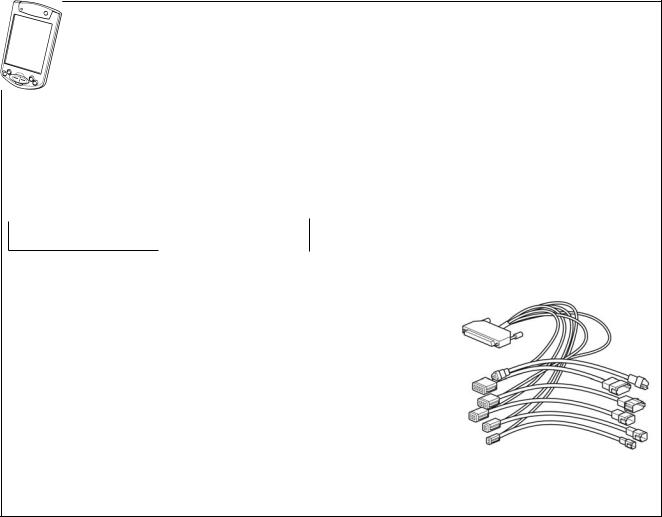
Special tools |
Group 30: Electrical system |
|
|
|
|
Special tools
3838620 |
3838621 |
3838622 |
3838619 |
|
885675 |
9812519 |
|
9999324 9998482
9998699 |
88890016 |
3838619 VODIA complete diagnostic tool.* Components:
3838620 VODIA – palmtop computer (PDA) with SD card.
3838621 VODIA – docking station. Used with VODIA PDA
(3838620).
3838622 VODIA – cable with connector. Used with docking station (3838621) on the engine’s communication connector.
*Note. More detailed information about using the VODIA tool can be found in the tool’s instruction manual.
885675 |
Adapter cable for sensor test |
9812519 |
Multimeter |
9999324 |
Terminal crimping tool |
9998482 |
Gauge for connector on control unit |
9998699 |
Measurebox |
88890016 |
Adapter cable |
7
EMS 2 - “Engine Management System” |
Group 30: Electrical system |
EMS 2 - “Engine Management System”
General information
EMS 2 is an electronic system with CAN communication (Controller Area Network) for diesel engine control. The system has been developed by Volvo and includes fuel control and diagnostic function.
The system consists of a control module, six injectors, a number of sensors that supply the control module with measurements, sockets for diagnosis and functional checks. The engine can be connected to a communications interface consisting of a CAN link and a serial link.
CAN - Controller Area Network
The J1939 CAN link is responsible after all communication between the engine control unit (EMS 2) and a communication interface (such as CIU/DCU), except for diagnostics. Diagnostics are managed by the socalled J1708/J1587 link. The CAN link is much faster than the J1708/J1587 link and has been designed to connect to other components that support the SAE J1939 protocol, such as instrument panels and transmissions.
If a fault develops on the CAN link, signals for the engine speed potentiometer, and the start and stop knobs are taken over by the J1708/J1587 link. However, instrument and indicator lamps are completely turned off.
If faults occur in both links, the engine starts to idle. The only way to shut off the engine in this case is to use the auxiliary stop (AUX-STOP).
8
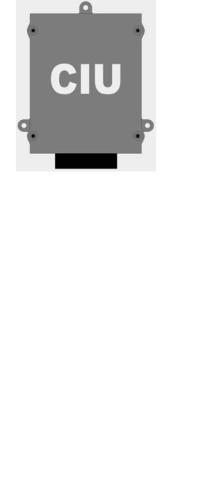
Group 30: Electrical system |
EMS 2 - “Engine Management System” |
|
|
CIU - Control Interface Unit
The CIU is a “translator” between the CAN bus and the customer’s own control panel. This unit has two serial communication links, one fast and one slow.
The fast one is a CAN link that features a bus speed of 250 Kbit/s. All data regarding instruments, indicator lamps, contacts and potentiometers are controlled by this bus.
The slower J1708/J1587 link handles diagnostic information for, among other things, the flashing code. The VODIA diagnosis tool also uses the J1708/J1587 link to communicate with the system.
DCU - Display Control Unit
DCU is a digital instrument panel that communicates with the engine control module via the CAN link. DCU has several functions, such as:
Engine control
– Start, stop, speed control, preheating etc.
Monitoring
– Engine speed, boost pressure, boost temperature, coolant temperature, oil pressure, oil temperature, engine hours, battery voltage, instantaneous fuel consumption and fuel consumption (trip fuel).
Diagnostics
– Shows fault codes in text. Lists previous faults.
Parameter setting
– Idling speed, alarm limit for oil temperature/coolant temperature, droop.
– Preheating for ignition.
Information
– Information about hardware, software and engine identification.
9
EMS 2 - “Engine Management System” |
Group 30: Electrical system |
Fuel control
The amount of fuel injected into the engine and the injection advance are fully electronically controlled, via fuel valves in the injectors, once the control unit has analyzed the engine’s fuel requirements.
This means that the engine always receives the correct volume of fuel in all operating conditions, which offers lower fuel consumption, minimal exhaust emissions etc.
The control unit monitors and reads the injectors to ensure that the correct volume of fuel is injected into each cylinder, and it calculates and set the injection advance. Control is mainly done with the help of the speed sensors, fuel pressure sensor and the combined sensor for boost pressure/boost temperature.
The control unit controls the injectors via a signal to the electromagnetically operated fuel valve in each injector, which can be opened and closed.
Calculation of fuel quantity
The quantity of fuel to be injected into the cylinder is calculated by the control unit. The calculation determines the time that the fuel valve is open (when the fuel valve is open fuel is sprayed into the cylinder).
The parameters which govern the amount of fuel injected are:
•Demanded engine speed
•Engine protector functions
•Temperature
•Boost pressure
Altitude correction
The control unit contains an atmospheric pressure sensor and an altitude compensation function for engines that operate at high altitude. This function limits the fuel volume in relation to ambient air pressure. This is to prevent smoke, high exhaust temperature and to protect the turbocharger from overspeeding.
Diagnostic function
The task of the diagnostic function is to discover and localize any malfunctions in the EMS 2 system, to protect the engine and to inform about any problems that occur.
If a malfunction is discovered, this is announced by warning lamps, a flashing diagnostic lamp or in plain language on the instrument panel, depending on the equipment used. If a fault code is obtained as a flashing code or in plain language, this is used for guidance in any fault tracing. Fault codes can also be read by Volvo’s VODIA tool at authorized Volvo Penta workshops.
In case of serious disturbances, the engine is shut down completely or the control module decreases the power output (depending on the application). Once again, a fault code is set for guidance in any fault tracing.
10
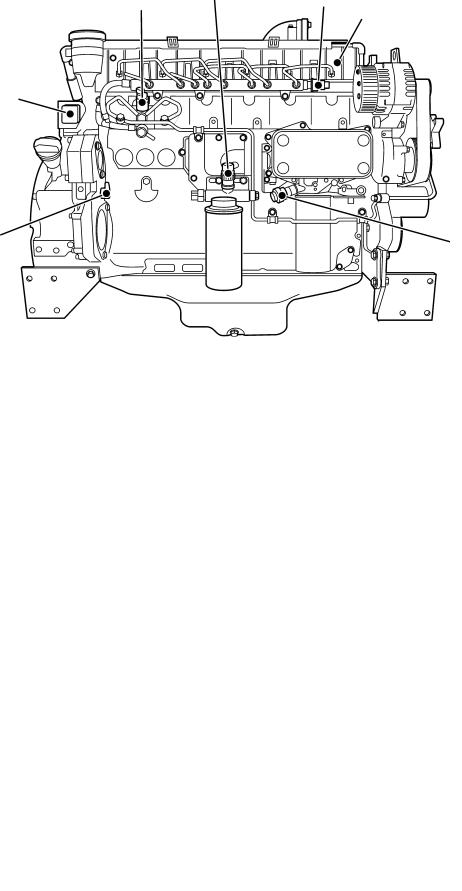
Group 30: Electrical system |
|
Component location |
|
||
Component location TAD 650, 660, 750, 760 VE |
||
NOTE! Location can differ, depending on engine model. |
4 |
5 |
3 |
|
|
1 |
7 |
|
1.Speed sensor, camshaft
2.Connection, EMS 2
3.Solenoid controlled proportional valve, high pressure pump – fuel (MPROP)
4.Fuel pressure
5.Fuel pressure in comman rail
6.Glow plugs, one for each injector
7.Oil pressure sensor
8.Boost pressure and temperature
9.Solenoid valve, EGR
10. Coolant temperature |
8 |
11.Speed sensor, crankshaft
12.Water in fuel (not shown, mounted fuel filter).
9
10
11
11
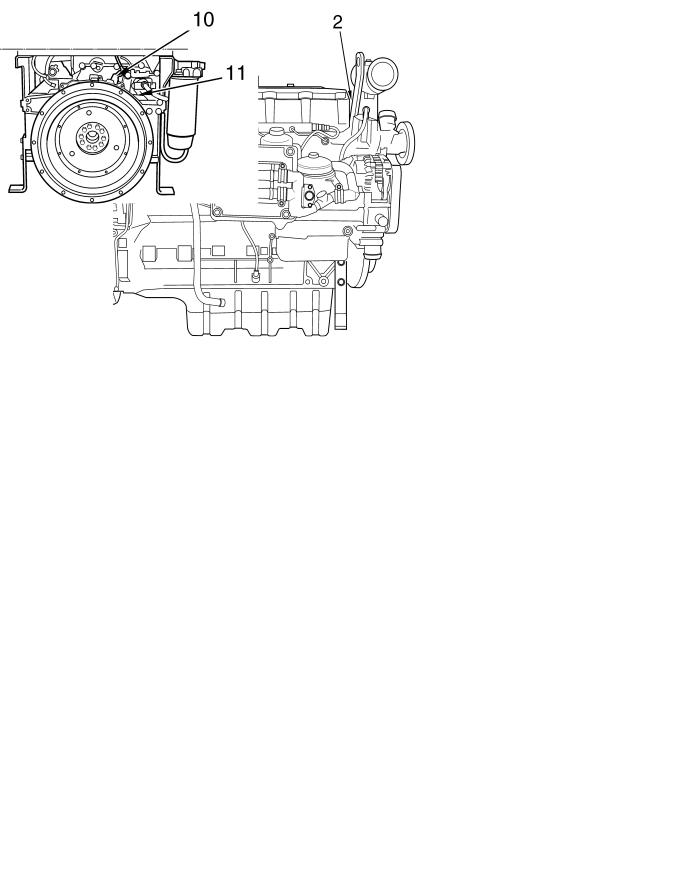
Component description |
Group 30: Electrical system |
|
|
Component location TAD 734 GE
1.Solenoid controlled proportional valve, high pressure pump – fuel (MPROP)
2.Coolant temperature sensor
3.Water in fuel switch(mounted on primary fuel filter).
4.Boost pressure and temperature sensor
5.Preheater, intake manifold
6.Fuel pressure in comman rail
7.Fuel pressure sensor
8.Oil pressure sensor
9.Main relay
10.Speed sensor, crankshaft
11.Speed sensor, camshaft
12
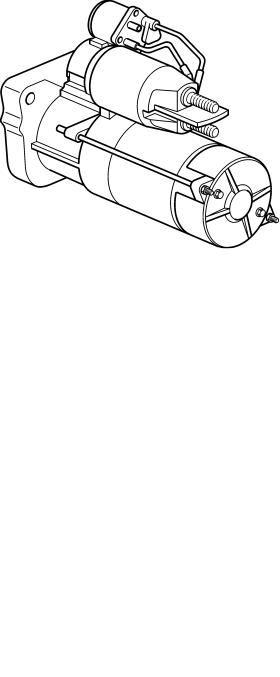
Group 30: Electrical system |
Component description |
|
|
Component description
Starter motor
The starter motor is installed in the flywheel housing, on the left-hand side of the engine. The starter motor relay is “positive connected”, which means that the relay is connected to battery voltage.
Alternator
The alternator is belt driven and mounted on the front of the engine, on the right.
13
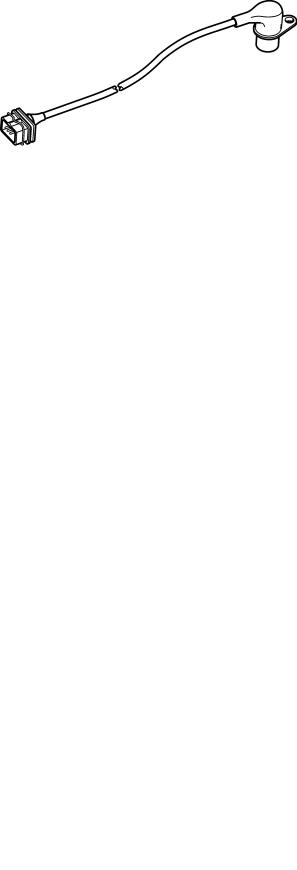
Component description |
Group 30: Electrical system |
|
|
Injectors
The injectors are installed on the cylinder head.
The amount of fuel injected and injection duration is controlled by the engine control unit, via electromagnetically controlled fuel valves in the injectors. This means that the engine always receives the correct volume of fuel in all operating conditions, which offers lower fuel consumption, minimal exhaust emissions etc.
Speed sensor, crankshaft
The engine speed sensor is an inductive sensor. When the crankshaft rotates impulses are created in the sensor via a tooth wheel on or behind the torsion damper. The impulses create a pulse signal in the sensor that the engine control unit (EMS 2) uses to calculate the crankshaft’s rpm.
The tooth wheel has a tooth free gap for the EMS 2 to recognize the crankshafts position.
The signal is sent to the engine control unit, which calculates the injection in advance and the amount of fuel to be injected.
Speed sensor, camshaft (camshaft position)
The camshaft sensor is an inductive sensor. When the camshaft rotates impulses are created in the sensor via a tooth wheel installed on the camshaft. The tooth has seven teeth, one for each cylinder and one to determine when cylinder one is to be injected. The impulses create a pulse signal in the sensor that the engine control unit (EMS 2) uses to calculate when a cylinder is in turn for injection.
14

Group 30: Electrical system |
Component description |
|
|
Sensor, boost pressure/ boost temperature
The boost pressure and the boost temperature are measured by a combined sensor located on the inlet manifold on the left of the engine.
The sensor is supplied by a 5 Volt reference voltage from the engine control module.
The boost pressure sensor measures the absolute pressure, which is the sum of the boost pressure and atmospheric pressure (300 kPa thus corresponds to a boost pressure of 200 kPa when atmospheric pressure is 100 kPa).
The pressure signal is a voltage signal which is proportional to absolute pressure.
The boost temperature sensor consists of a non-lin- ear resistor, whose resistance varies with boost temperature. The resistance falls as the temperature rises.
Sensor, oil pressure, engine
Oil pressure is measured by a sensor installed in the engine block on the right side of the engine.
The sensor measures pressure in the main oil gallery, and is supplied by a 5 Volt reference voltage from the engine control module.
The pressure signal is a voltage signal which is proportional to the lubrication oil pressure.
IEGR (only VE engines)
The IEGR valve is a 2-way solenoid valve controlled by the engine control unit. The IEGR solenoid controls a oil pressure that effects a control valve which activate the exhaust gas recirculation function.
15

Component description |
Group 30: Electrical system |
|
|
Coolant temperature sensor
The sensor is located on the cylinder head, at the rear end of the engine.
The sensor senses the engine coolant temperature and sends the information to the engine control unit. The sensor consists of a non-linear resistor, whose resistance varies with coolant temperature. The resistance falls as the coolant temperature rises.
Sensor, common rail pressure (fuel)
The sensor is mounted on the right of the engine, at the front of the common rail, which distributes fuel to the injectors.
The rail pressure sensor senses the fuel pressure and converts this to a voltage which is registered by the engine control unit.
Sensor, fuel pressure
The sensor measures fuel pressure and is located on the fuel filter bracket. The sensor is an active sensor, i.e. the sensor requires a supply voltage of +5 Volt.
The sensor provides an output signal whose voltage is proportional to the pressure that the sensor measures.
16

Group 30: Electrical system |
Component description |
|
|
Magnetically controlled proportional valve (MPROP)
A magnetically controlled proportional valve (MPROP) controls the high pressure pump to ensure that the correct fuel pressure (rail pressure) is retained despite varying engine speed and loading.
The input signal to the valve is a PWM signal whose pulse width is controlled by the engine control module.
When the current through the valve is changed, this affects the fuel flow, which results in changed rail pressure.
Water in fuel switch, secondary fuel filter
A switch is located in the water trap under the fuel filter. Its task is to detect whether there is water in the fuel.
The switch senses the resistance between two pins, wich are in contact with the fuel. When there is no water in the fuel, the resistance is very high. If there is any water in the fuel, the resistance falls.
Switch, coolant level
The task of the switch is to discover whether the coolant level in the engine (expansion tank) has become too low. An alarm signal is sent when the coolant level is too low.
17
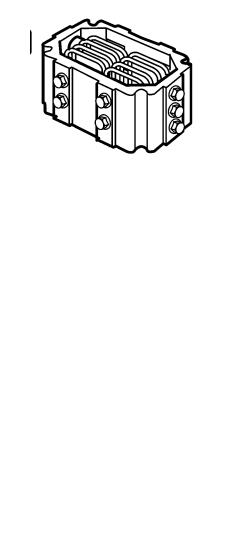
Component description |
Group 30: Electrical system |
|
|
Preheater with preheater relay
The preheater is located in the inlet manifold at the left side of the engine. The preheat relay is located at the engines left side beneath the preheater.
Engine control unit, EMS 2
The engine control unit checks and controls the injectors, to ensure that the correct volume of fuel is injected into each cylinder at the right time. It also controls the high pressure pump via the proportional valve (MPROP) to ensure that the system always has the correct fuel pressure (rail pressure).
The control unit also calculates and adjusts the injection advance. Regulation is mainly done with the aid of the engine speed sensor and the combined sensor for boost pressure/boost temperature.
The EMS 2 system processor is located in the control unit, protected from water and vibration.
The processor receives continuous information about:
•
•
•
•
•
•
•
•
Engine speed Throttle
Oil pressure
Boost pressure /temperature
Fuel pressure (common rail pressure) Fuel alarm, “water in fuel”
Camshaft position Coolant temperature
The information provides information about current operation conditions and allows the processor to calculate the correct fuel volume, monitor engine status etc.
18

Group 30: Electrical system |
Repair instructions |
|
|
Repair instructions
General advice on working with EMS engines
The following advice must be followed to avoid damage to the engine control unit and other electronics.
IMPORTANT! The system must be disconnected from system voltage (by cutting the current with the main switch) and the starter key(s) must be in the 0 position when the engine control module connectors are disconnected or connected.
● Never disconnect the current with the main switches when an engine is running.
● Never undo a battery cable when the engine is running.
● Turn the main switches off or disconnect the battery cables during quick charging of the batteries.
● NOTE! During normal trickle charging, it is not necessary to turn the main switches off.
● Only batteries may be used for start help. A help start device can produce a very high voltage and damage the control unit and other electronics.
● If a connector is disconnected from a sensor, be very careful to avoid allowing the contact pins to come into contact with oil, water or dirt.
19
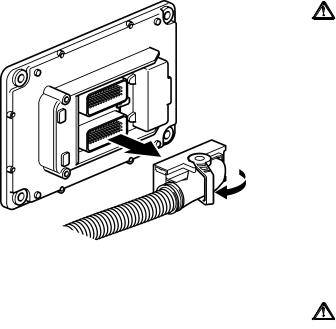
Repair instructions |
Group 30: Electrical system |
|
|
Electric welding
1. NOTE! Cut the current with the main switch.
IMPORTANT! The system must be disconnected from system voltage when the engine control module connectors are disconnected or connected.
2. Undo the two connectors from the engine control unit before any electric welding starts. Turn the locking arm down at the same time as the connector is pulled outwards.
3. Disconnect all connections to the alternator.
Connect the welder earth clamp to the component to be welded, or as close as possible to the weld site. The clamp must never be connected to the engine or in such a way that current can pass through a bearing.
IMPORTANT! After welding is completed, the disconnected components, such as alternator cables and battery cables must be connected in the correct order.
The battery cables must always be connected last.
20

Group 30: Electrical system |
Repair instructions |
|
|
Changing the engine control unit
1. NOTE! Cut the current with the main switch.
IMPORTANT! The system must be disconnected from system voltage when the engine control module connectors are disconnected or connected*.
2. Remove the two connectors from the engine control unit. Turn the locking arm down at the same time as the connector is pulled outwards
3. If the new engine control unit has recently been programmed:
Start the engine and check whether any fault codes related to the engine control unit occur.
21
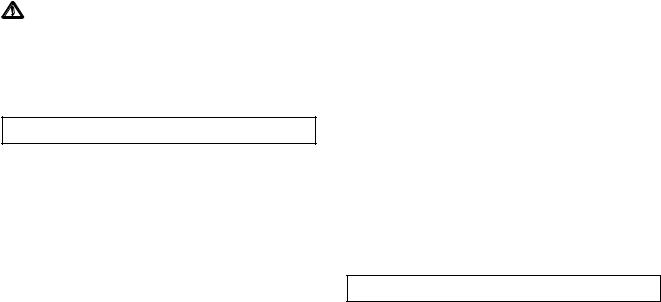
Repair instructions |
Group 30: Electrical system |
|
|
Reprogramming a control unit
IMPORTANT! The CHASSIS ID number must be readily available to allow the software to be downloaded.
Action:
1.Log in to Volvo Penta Partner Network’s website:
www.vppn.com
2.Choose “VODIA” in the left-hand menu.
3.Choose “ECU programming” in the left-hand menu.
4.Follow the instructions under “Download software”. Choose the control units to be reprogrammed and click the “Download” button. The software for the control units is now downloaded to the PDA*.
* Note. PDA = “Personal Digital Assistant” (palmtop computer).
5.Take a look under “Settings”, “Software information” in VODIA to check that the software has been downloaded.
6.Connect the VODIA to the engine (control unit) to be programmed.
7.Start with the engine control unit.
Select “Engine with mounting and equipment” in the VODIA menu.
Select “MID 128 Control unit, programming”.
VODIA will guide you through the entire programming process.
8.The next control unit is the vehicle ECU.
Select “Electrical system and instruments” in the VODIA menu.
Select “MID 144 ECU, programming”.
VODIA will guide you through the entire programming process.
9.NOTE! Programming must be reported back to Volvo Penta within 28 days. Log in to Volvo Penta Partner Network’s web site:
www.vppn.com
10.Choose “VODIA” in the left-hand menu.
11.Choose “Report software” in the left-hand menu.
12.Follow the instructions for “Report software/parameter”. Click “Report software/parameter”.
22

Group 30: Electrical system |
Repair instructions |
|
|
Programming an empty control unit
When a new engine control unit is installed, where no software has been downloaded, the control unit must be programmed.
The new control unit must have the same part number as the old control unit. If the control units do not have the same part number, it will not be possible to program the new control unit until a “Conversion kit” has been ordered from Volvo Penta.
If the control units have the same part number, the new control unit can be programmed as usual. Please refer to “Programming a control unit”.
If the part numbers do not coincide – proceed as possible:
1. Have both part numbers available.
2. Log in to Volvo Penta Network’s web site:
www.vppn.com
3. Choose “VODIA” in the left-hand menu.
4. Choose “Conversion kit” in the left-hand menu. A new page, “Conversion kit / Accessory kit”, opens up.
5. Click the text “Available conversions kits” which is shown in bold face.
6. A new window opens. Follow the instructions given in the window.
7. Return to the “Conversion kit / Accessory kit” page and follow the instructions to order a new “conversion kit”.
8. Volvo Penta’s database is now updated. It can take about a minute before a confirmation is sent.
9. Programing of the control unit can now start. Please refer to “Programming a control unit”.
23
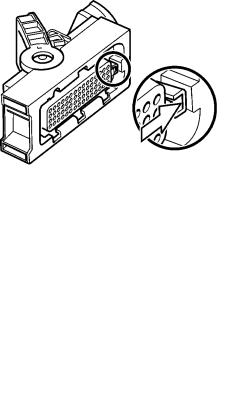
Repair instructions |
Group 30: Electrical system |
|
|
Fault tracing of cables and connectors
Special tools: 9812519, 999 8482
Check all connectors visually
Check the following:
Look for oxidation which can impair contact in connectors.
Check that terminals are undamaged, that they are correctly inserted into their connectors, and that the cable is correctly terminated in the terminal.
●Check that there is good mechanical contact in the connector. Use a loose pin to check this.
IMPORTANT! The multi-pin connectors for the engine control unit must only be checked with gauge 9998482.
●Carefully insert gauge 9998482 into the multi-pin connector. Pull and push the connector in and out a few times and feel whether the terminal socket grasps the tool. If the terminal socket does not grasp, or if it feels slack, the connection pins should be changed. Please refer to ”Joining electrical cables for multi-connector” Check the secondary locking in the connector.
●If possible, shake the cables and pull the connectors during measurement to discover whether the cable harness is damaged.
●Check that the cables are not damaged. Avoid clamping cables in tight bends close to the connector.
●Check the function of the secondary locking.
Contact problems
Intermittent contact or temporary recurring faults can be difficult to fault trace, and are frequently caused by oxidation, vibration or poorly terminated cables.
Wear can also cause faults. For this reason, avoid disconnecting a connector unless it is necessary.
Other contact problems can be caused by damage to pins, sockets and connectors etc.
Shake cables and pull connectors during measurement, to find where the cable is damaged.
Contact resistance and oxidation
Resistance in connectors, cables and junctions should be close to 0 Ω. A certain amount of resistance will occur, however, because of oxidation in connectors.
If this resistance is too great, malfunctions occur. The amount of resistance that can be tolerated before malfunctions occur varies, depending on the load in the circuit.
Open circuit
Possible reasons for faults could be chafed or broken cables, or connectors which have come undone.
Use the wiring schedule to check the cable harnesses which are relevant to the function. Start off with the most probable cable harness in the circuit.
Check the following:
●Disconnect the relevant connector at each end of the cable harness.
●Use multimeter 9812519 to measure the resis-
tance between the ends of the cable.
Nominal value close to 0 Ω.
●If possible, shake the cables and pull the connectors during measurement to discover whether the cable harness is damaged.
●Check the next cable harness in the wiring schedule if no fault has been found.
24

Group 30: Electrical system |
Repair instructions |
|
|
Joining electrical cables for connectors
Special tools: 9808648, 999 9324
Repair kit: 107 8054
1
Disconnect the connector from the engine control unit or from the power supply unit, please refer to ”Control unit, changing”.
Undo the connector, to gain access to the cable leading to the pin which is to be changed.
2
Undo the pin catch.
3
Remove the pin with tool no. 9808648.
NOTE! Only remove one pin at a time.
4
Cut off the cable and the pin which is to be changed. Join the cable with the new one, using repair kit 10.78054. Use cable crimping tool no. 999 9324.
5
Carefully heat the joint with a hot air gun, to make the insulation shrink and seal tightly.
25
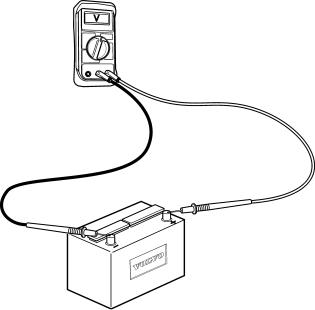
Repair instructions |
Group 30: Electrical system |
|
|
6
Put the pin back in the right place in the connector before removing the next pin, if several pins are to be changed. Check that the locking tongue locks the pin in the connector.
7
Install the cables with insulation and tie wraps in the connector, in the reverse order to disassembly.
8
Install the connector in the reverse order to disassembly.
9
Check that the connector and the mating connector on the engine control unit or power supply unit are clean and dry.
10
Join up the multi-pin connector. Please refer to ”Control unit, changing” for advice on joining up the connector.
11
Start the engine and check carefully that no fault codes occur.
Checking the starter motor voltage
Special tools: Multimeter 981 2519
General
If battery voltage falls below 24.7 V*, the starter motor will not be able to crank the engine at normal speed.
A fully charged battery has an open circuit voltage of about 25.4 V.
* Note. Measured on the batteries.
Voltage measurement, check 1
Check that the battery voltage is at least 24.7 V* when unloaded by using multimeter 9812519 to measure between the battery poles.
* Note. Measured on the batteries.
2
Turn the main switch on.
3
Check that the voltage between terminal B+ on the starter motor and battery negatives connection point is the same as the battery voltage.
26
Group 30: Electrical system |
Repair instructions |
|
|
Checking the charging system
Special tools: 9812519
Generally about alternators:
The voltage output from an alternator must be limited to prevent the elecrolyte in the battery to evaporate. The alternator output is regulated (limited) by the voltage regulator in the alternator. The maximum current that the alternator can deliver at regulated voltage output depends on the alternator revolution. When the engine is started an excitation current is needed to “wake up” the alternator.
NOTE! It is the consumers (batteries included) which decides the output current from the alternator.
Measurements
1.Engine off.
2.Use multimeter 9812519 to do a voltage measurement over the battery. The nominal voltage over a full loaded battery is approx. 25.4V.
3.Engine on. Run at 1500 rpm.
4.Use multimeter 9812519 to do a voltage measurement over the battery. The nominal charging voltage over the battery should be approx. 27.8- 28.6V.
Fault tracing charging system
Battery
1.Check that all connectors at the battery is correct assembled.
2.Check the conditions of the cables to the battery.
3.Check the water level in the battery.
4.Check, if possible, the specific gravity of all cells.
when no charge
1.Check the alternator belt tension.
2.Check that all connectors at the alternator and at the battery is correct assembled.
3.Check the conditions of all cables in the charging system.
4.Regulator fault, try another alternator.
when undercharge
1.Check the alternator belt tension.
2.Check that all connectors at the alternator and at the battery is correct assembled.
3.Check the conditions of all cables in the charging system.
4.Regulator fault, try another alternator.
when overcharge
1.Probably regulator fault, try another alternator.
27
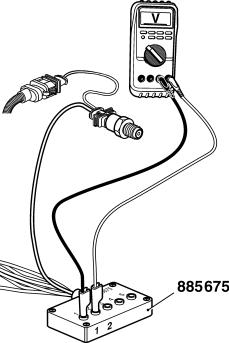
Repair instructions |
Group 30: Electrical system |
|
|
Rail pressure measurement
This measurement is used for measuring the rail pressure. For example if the engine doesn’t start this measurement can show the rail pressure while the engine is cranking. If it is air in the system the rail pressure could be too low for the engine control unit to activate injection.
1. NOTE! Starter key in position 0.
2. Undo the connector from the sensor.
3. Connect adapter cable (885675) between the sensor and the engine control unit.
4. Use multimeter (9812519) for voltage measurement. Connect the COM from the multimeter to measurement point 1. Connect V from the multimeter to measurement point 2.
5. NOTE! Starter key in position I. The multimeter should now show 0.5 Volt which is equal to 0Mpa (0bar).
6. When cranking the engine, read the voltage value on the multimeter and look in the table which pressure the voltage equals.
NOTE! To activate injection a rail pressure of at least 25 MPa (250 bar) is demanded.
Voltage |
0.5 |
0.95 |
1.0 |
1.1 |
1.2 |
1.3 |
1.4 |
1.5 |
1.6 |
1.7 |
MPa |
0 |
20.3 |
22.5 |
27.0 |
31.5 |
36.0 |
40.5 |
45.0 |
49.5 |
54.0 |
|
|
|
|
|
|
|
|
|
|
|
Bar |
0 |
203.0 |
225.0 |
270.0 |
315.0 |
360.0 |
405.0 |
450.0 |
495.0 |
540.0 |
|
|
|
|
|
|
|
|
|
|
|
Voltage |
1.8 |
1.9 |
2.0 |
2.1 |
2.2 |
2.3 |
2.4 |
2.5 |
2.6 |
2.7 |
|
|
|
|
|
|
|
|
|
|
|
MPa |
58.5 |
63.0 |
67.5 |
72.0 |
76.5 |
81.0 |
85.5 |
90.0 |
94.5 |
99.0 |
Bar |
585.0 |
630.0 |
675.0 |
720.0 |
765.0 |
810.0 |
855.0 |
900.0 |
945.0 |
990.0 |
|
|
|
|
|
|
|
|
|
|
|
Voltage |
2.8 |
2.9 |
3.0 |
3.1 |
3.2 |
3.3 |
3.4 |
3.5 |
3.6 |
3.7 |
|
|
|
|
|
|
|
|
|
|
|
MPa |
103.5 |
108.0 |
112.5 |
117.0 |
121.5 |
126.0 |
130.5 |
135.0 |
139.5 |
144.0 |
|
|
|
|
|
|
|
|
|
|
|
Bar |
1035.0 |
1080.0 |
1125.0 |
1170.0 |
1215.0 |
1260.0 |
1305.0 |
1350.0 |
1395.0 |
1440.0 |
Voltage |
3.8 |
3.9 |
4.0 |
4.1 |
4.2 |
4.3 |
4.4 |
4.5 |
|
|
|
|
|
|
|
|
|
|
|
|
|
MPa |
148.5 |
153.0 |
157.5 |
162.0 |
166.5 |
171.0 |
175.5 |
180.0 |
|
|
Bar |
1485.0 |
1530.0 |
1575.0 |
1620.0 |
1665.0 |
1710.0 |
1755.0 |
1800.0 |
|
|
|
|
|
|
|
|
|
|
|
|
|
28
